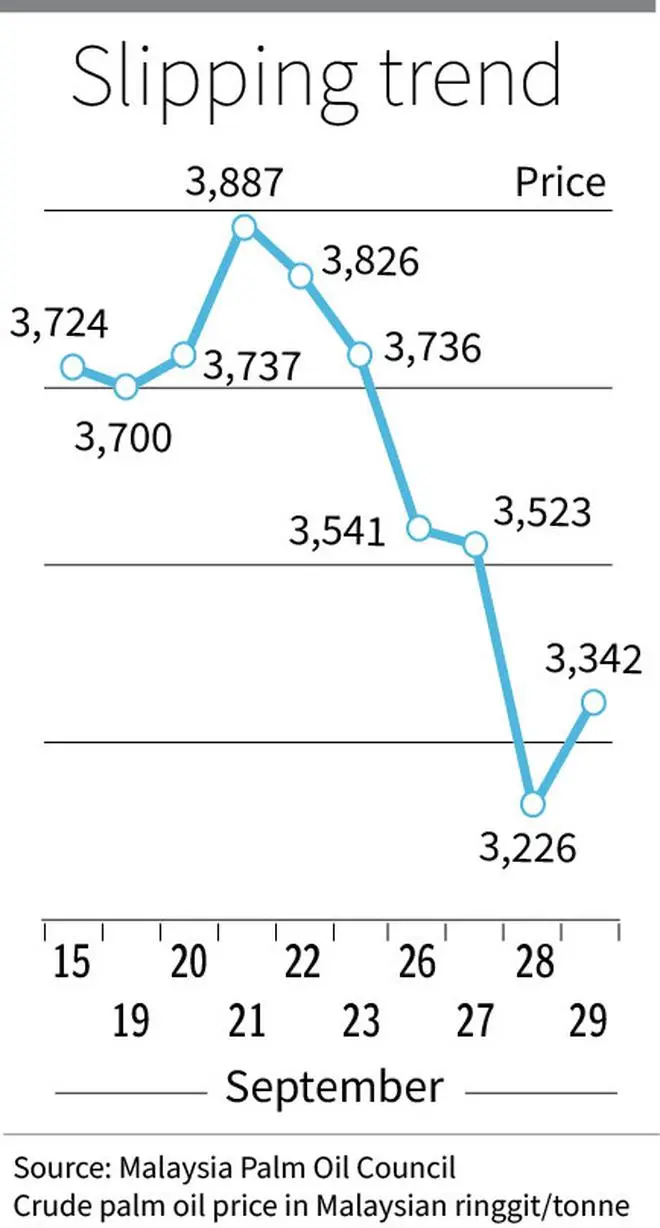Palm oil prices nosedived to a 20-month low earlier this week but managed to make a modest recovery during the weekend. Prices are likely to be under pressure on higher inventories and peak production season and the bottom is a little away, trade and industry officials say.
“The palm oil market has almost reached the bottom. I don’t think it will drop much from here as production costs are higher at around 2,500 Malaysian ringgit (MYR). Palm oil exports have also been good in September, which could spark the market,” said Abdul Hameed, Director- Sales, Manzoor Trading in Lahore, Pakistan.

More fall on cards?
Pointing to forecasts by Dorab Mistry, Godrej International Director and a palm oil market expert, that prices of the oil could drop to 3,000 MYR, BV Mehta, Executive Director, Solvent Extractors Association of India (SEA), said there could be some more dip in the commodity’s prices from current levels.
On Friday, crude palm for delivery in December on Bursa Malaysia Derivatives Exchange ended at 3,418 MYR a tonne. Prices are down by 52 per cent after the peak seen in April this year, following Indonesia’s ban on palm oil exports.
Palm oil prices are down nearly 25 per cent year-on-year. Over the past month, prices have dropped by 15 per cent and this week, they have declined by 8.5 per cent.
According to inspection agency Amspec, Malaysian palm oil exports increased by over 10 per cent to 1.32 million tonnes (mt) in September compared with 1.19 mt in August.
Exports may rise
Hameed said other agencies which put out export data could peg the shipments higher. “The going looks good on the export front with shipments likely to increase over 15 per cent. It will spark the market once again given the seasonal and festive demand ahead,” he said.
“The problem with palm oil is that Indonesia could have about 7 mt stocks. Malaysia could have another 2 mt. Oil palm plantations’ labour issue has been solved and the peak production season is on. At the same time, demand is slack,” said SEA’s Mehta.
Hameed said palm oil’s advantage is that it is now the cheapest oil after being the priciest in April. In dollar terms, it costs less than $750 a tonne free-on-board compared with $1,415 for soyabean and $1,265 for sunflower oil.
Funds play likely
“Funds and investors can take palm oil prices to 4,000 MYR with India playing a vital role in driving up the consumption. However, India could hike the duty on palm oil to protect its farmers since kharif oilseeds harvest has begun,” Hameed said.
“India has ample edible oil stocks with it. Why should it buy when prices are falling? The fact is supplies are higher than demand and China has complicated the situation by refraining from any purchase,” said Mehta.
He agreed with Hameed that the Indian government could hike the duty on palm oil to protect its farmers since prices of soyabean have dropped to ₹5,000 a quintal and could drop further below the minimum support price (MSP).
For the current crop year, the Centre has fixed soyabean MSP at ₹4,300 a quintal.
Falling ringgit
Hameed said the Ukraine war could also have an impact since Europe could face problems during winter. “But the negative soyabean crushing margin could again put pressure on palm oil next week,” he said.
Analysts said palm oil faced problems due to a depreciating ringgit, which might help exports but not reverse the current downtrend.
Meanwhile, Indonesia, in an effort to export more palm oil, cut its reference price to $792.19 a tonne for October 1- 15 shipments, compared with $846.21 for September 16-30. This will set the export tax for crude palm oil at $33 a tonne from the previous $124.
Last week, Fadhil Hasan, Head of Trade and Promotion, Indonesia Palm Oil Association (GAPKI), told businessline that Jakarta will likely allow shipments of palm oil without levy until the year-end.








Comments
Comments have to be in English, and in full sentences. They cannot be abusive or personal. Please abide by our community guidelines for posting your comments.
We have migrated to a new commenting platform. If you are already a registered user of TheHindu Businessline and logged in, you may continue to engage with our articles. If you do not have an account please register and login to post comments. Users can access their older comments by logging into their accounts on Vuukle.